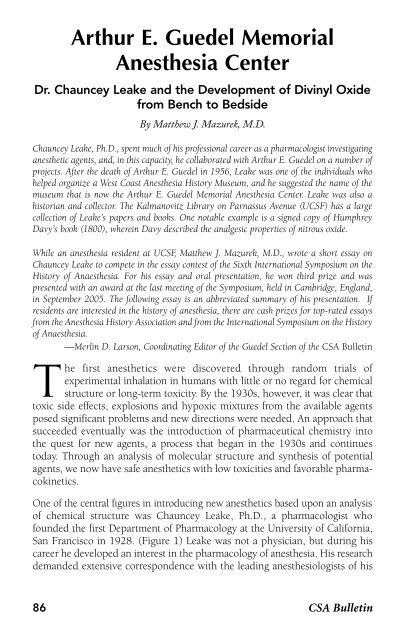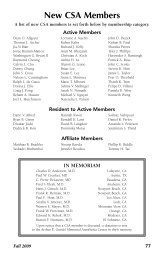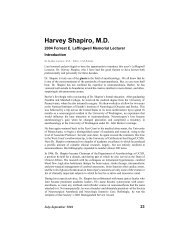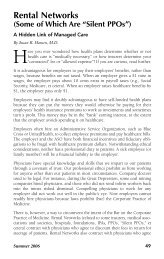Arthur E. Guedel Memorial Anesthesia Center - California Society of ...
Arthur E. Guedel Memorial Anesthesia Center - California Society of ...
Arthur E. Guedel Memorial Anesthesia Center - California Society of ...
You also want an ePaper? Increase the reach of your titles
YUMPU automatically turns print PDFs into web optimized ePapers that Google loves.
<strong>Arthur</strong> E. <strong>Guedel</strong> <strong>Memorial</strong><br />
<strong>Anesthesia</strong> <strong>Center</strong><br />
Dr. Chauncey Leake and the Development <strong>of</strong> Divinyl Oxide<br />
from Bench to Bedside<br />
By Matthew J. Mazurek, M.D.<br />
Chauncey Leake, Ph.D., spent much <strong>of</strong> his pr<strong>of</strong>essional career as a pharmacologist investigating<br />
anesthetic agents, and, in this capacity, he collaborated with <strong>Arthur</strong> E. <strong>Guedel</strong> on a number <strong>of</strong><br />
projects. After the death <strong>of</strong> <strong>Arthur</strong> E. <strong>Guedel</strong> in 1956, Leake was one <strong>of</strong> the individuals who<br />
helped organize a West Coast <strong>Anesthesia</strong> History Museum, and he suggested the name <strong>of</strong> the<br />
museum that is now the <strong>Arthur</strong> E. <strong>Guedel</strong> <strong>Memorial</strong> <strong>Anesthesia</strong> <strong>Center</strong>. Leake was also a<br />
historian and collector. The Kalmanovitz Library on Parnassus Avenue (UCSF) has a large<br />
collection <strong>of</strong> Leake’s papers and books. One notable example is a signed copy <strong>of</strong> Humphrey<br />
Davy’s book (1800), wherein Davy described the analgesic properties <strong>of</strong> nitrous oxide.<br />
While an anesthesia resident at UCSF, Matthew J. Mazurek, M.D., wrote a short essay on<br />
Chauncey Leake to compete in the essay contest <strong>of</strong> the Sixth International Symposium on the<br />
History <strong>of</strong> Anaesthesia. For his essay and oral presentation, he won third prize and was<br />
presented with an award at the last meeting <strong>of</strong> the Symposium, held in Cambridge, England,<br />
in September 2005. The following essay is an abbreviated summary <strong>of</strong> his presentation. If<br />
residents are interested in the history <strong>of</strong> anesthesia, there are cash prizes for top-rated essays<br />
from the <strong>Anesthesia</strong> History Association and from the International Symposium on the History<br />
<strong>of</strong> Anaesthesia.<br />
—Merlin D. Larson, Coordinating Editor <strong>of</strong> the <strong>Guedel</strong> Section <strong>of</strong> the CSA Bulletin<br />
The first anesthetics were discovered through random trials <strong>of</strong><br />
experimental inhalation in humans with little or no regard for chemical<br />
structure or long-term toxicity. By the 1930s, however, it was clear that<br />
toxic side effects, explosions and hypoxic mixtures from the available agents<br />
posed significant problems and new directions were needed. An approach that<br />
succeeded eventually was the introduction <strong>of</strong> pharmaceutical chemistry into<br />
the quest for new agents, a process that began in the 1930s and continues<br />
today. Through an analysis <strong>of</strong> molecular structure and synthesis <strong>of</strong> potential<br />
agents, we now have safe anesthetics with low toxicities and favorable pharmacokinetics.<br />
One <strong>of</strong> the central figures in introducing new anesthetics based upon an analysis<br />
<strong>of</strong> chemical structure was Chauncey Leake, Ph.D., a pharmacologist who<br />
founded the first Department <strong>of</strong> Pharmacology at the University <strong>of</strong> <strong>California</strong>,<br />
San Francisco in 1928. (Figure 1) Leake was not a physician, but during his<br />
career he developed an interest in the pharmacology <strong>of</strong> anesthesia. His research<br />
demanded extensive correspondence with the leading anesthesiologists <strong>of</strong> his<br />
86 CSA Bulletin
<strong>Guedel</strong> (cont’d)<br />
Chauncey Leake, Ph.D.<br />
(1896-1978)<br />
BA, 1917, Princeton<br />
Philosophy, chemistry, biology<br />
PhD, 1923, Univ <strong>of</strong> Wisconsin,<br />
Physiology and Pharmacology<br />
U.S.Army Chemical Warefare Service,<br />
Madison, 1917-19<br />
1923-28, Asst. Assoc. Pr<strong>of</strong>.<br />
Pharmacology, UW, Madison<br />
1928-1942 Pr<strong>of</strong>. Chair,<br />
Pharmacology, UCSF<br />
1964-1978, Emeritus Pr<strong>of</strong>.<br />
Pharmacology, UCSF<br />
Figure 1. Chauncey Leake, Ph.D.<br />
Courtesy <strong>of</strong> University <strong>of</strong> <strong>California</strong>, San Francisco.<br />
era, and these records provide a unique historical repository to examine the<br />
origins <strong>of</strong> our specialty.<br />
In 1930 Leake and Mei-Yu Chen surmised that if a new compound—divinyl<br />
oxide (divinyl ether, vinyl oxide, vinyl ether, and Vinethene ® )—could be<br />
synthesized, it would combine the anesthetic properties <strong>of</strong> ether and ethylene,<br />
thereby providing a more desirable agent. Their idea was that if an unsaturated<br />
carbon atom, present in ethylene, was introduced into the ether molecule, it<br />
would improve its anesthetic properties. (Figure 2)<br />
Ethylene: CH2= CH2<br />
Ether: CH2CH3-O-CH2CH3<br />
Divinyl Oxide: CH2=CH-O-CH=CH2<br />
Figure 2. The Chemical Structure <strong>of</strong> Ethylene, Ether,<br />
and Divinyl Oxide Compared<br />
Leake’s pivotal role in the development <strong>of</strong> divinyl oxide had its roots planted<br />
firmly in his work with ether and ethylene at the University <strong>of</strong> Wisconsin,<br />
Madison. In a personal interview with Leake in 1977, he states:<br />
Winter 2007 87
<strong>Guedel</strong> (cont’d)<br />
When I was at Wisconsin I had worked on ether, among other<br />
things; also on a new anesthetic agent, namely ethylene. Now ethylene<br />
has a double-bond in the carbons; ether does not. Ethylene is an<br />
excellent anesthetic agent, and is better than nitrous oxide, and has<br />
certain advantages over ether. So, I thought: Why don’t we combine<br />
the chemical configuration <strong>of</strong> the double-bond carbon? Well, there<br />
wasn’t any such thing at the time.<br />
Leake, however, was not the first to suggest synthesis <strong>of</strong> divinyl oxide. It had<br />
been synthesized in very small, impure quantities by several organic chemists.<br />
With the seeds for this potentially new anesthetic planted firmly in his mind<br />
before he left Wisconsin, Leake then had the challenge <strong>of</strong> obtaining divinyl<br />
oxide for study.<br />
After Leake’s move to establish the new Department <strong>of</strong> Pharmacology at the<br />
University <strong>of</strong> <strong>California</strong>, San Francisco, it was logical for him to approach the<br />
organic chemists at the University <strong>of</strong> <strong>California</strong>, Berkeley to synthesize divinyl<br />
oxide. Leake’s colleagues at Berkeley were unable to synthesize divinyl oxide,<br />
and he finally received some impure samples from Randolph Major, a graduate<br />
chemistry student working with Pr<strong>of</strong>essor Lauder Jones at Princeton<br />
University.<br />
After obtaining the samples from Major, Leake and Chen studied it briefly in<br />
mice and published their report in 1930 on its anesthetic properties, concluding<br />
with the statement, “Further study <strong>of</strong> this interesting series <strong>of</strong> agents is justified<br />
and is cordially invited.” Leake then collaborated with <strong>Arthur</strong> <strong>Guedel</strong> on<br />
further work with animals that was published in 1932.<br />
Although <strong>Guedel</strong> did not seem interested in using the drug on humans,<br />
Chauncey Leake and Ralph Waters were close personal friends, so it comes as<br />
no surprise that Leake asked Waters to study divinyl oxide. In a letter to Waters<br />
dated November 14, 1931, Leake states:<br />
As you probably know we have been fooling with divinyl oxide…We<br />
obtained a very pure sample <strong>of</strong> this substance from Dr. Randolph T.<br />
Major…While it is inflammable like ether, it is much more rapid in<br />
its action and has apparently a wider margin <strong>of</strong> safety than ether. It<br />
does not cause the salivation or the mucous flow so characteristic <strong>of</strong><br />
ether inhalation. It seemingly has much less effect on the metabolic<br />
functions <strong>of</strong> the body ha [sic] reflected in pH or blood gas changes<br />
as any <strong>of</strong> the common anesthetic agents. In other words, I am<br />
altogether convinced it is a damn good anesthetic. How would you<br />
like to study a little <strong>of</strong> it in dogs, maybe to check up on me, and then<br />
try it out in the hospital?<br />
88 CSA Bulletin
<strong>Guedel</strong> (cont’d)<br />
Waters received his first supplies <strong>of</strong> divinyl oxide from Major and immediately<br />
had trouble with the agent while attempting to anesthetize a few dogs. One<br />
suffered from cardiac arrest after much salivation, and the other was successfully<br />
resuscitated. Correspondence between Waters and Leake led to the mutual<br />
conclusion that the samples that Waters obtained were contaminated with<br />
impurities, either formaldehyde or formic acid.<br />
In January 1933, Samuel Gelfan and Irving Bell, anesthesiologists from the<br />
University <strong>of</strong> Alberta, Canada, published a paper on the anesthetic action <strong>of</strong><br />
divinyl oxide in humans. They were extremely fortunate to have pure divinyl<br />
oxide to use. This brief study was published in the Journal <strong>of</strong> Experimental<br />
Pharmacology and Therapeutics and describes the anesthetic experience <strong>of</strong><br />
Samuel Gelfan as he was administered the agent with the open-drop technique.<br />
According to Leake, Dr. Mary Botsford, chief anesthesiologist at the University<br />
<strong>of</strong> <strong>California</strong>, San Francisco, was the first to administer divinyl oxide for a<br />
clinical case. This first use <strong>of</strong> the agent in the operating room was for a<br />
hysterectomy in early January 1932.<br />
Unfortunately, the political climate at the University <strong>of</strong> <strong>California</strong> undermined<br />
Leake’s efforts to perform a large clinical study, and many <strong>of</strong> the anesthetists at<br />
the University <strong>of</strong> <strong>California</strong> were not impressed with divinyl oxide. This must<br />
have disappointed Leake, as it was studied extensively at other institutions.<br />
Leake’s divinyl oxide had some success, but questions arose regarding liver<br />
toxicity, and there were other concerns about purity <strong>of</strong> the agent during<br />
storage. Several colleagues were blunt in their assessment that it was not a<br />
good anesthetic and could not be recommended. Of course, the agent suffered<br />
from the flammability problem common to that era.<br />
However, Leake and Chen made important contributions in their approach to<br />
the development <strong>of</strong> safer agents. With their analytic methods, they paved the<br />
way for others who used chemical synthetic methods to fluorinate the hydrocarbon<br />
molecule and produce nonflammable agents.<br />
(References available on request)<br />
<strong>Arthur</strong> E. <strong>Guedel</strong> <strong>Memorial</strong> <strong>Anesthesia</strong> <strong>Center</strong><br />
2395 Sacramento Street, San Francisco, CA 94115<br />
(415) 923-3240; http://www.cpmc.org/pr<strong>of</strong>essionals/hslibrary/collections/guedel<br />
Winter 2007 89






